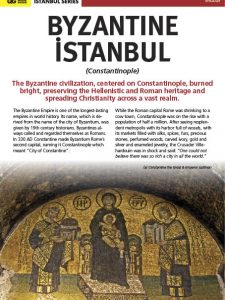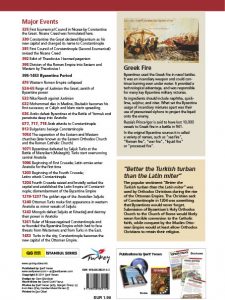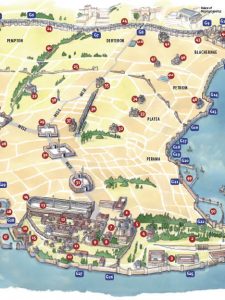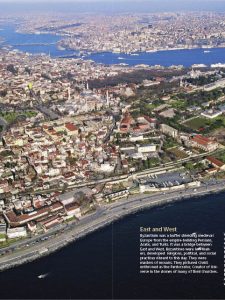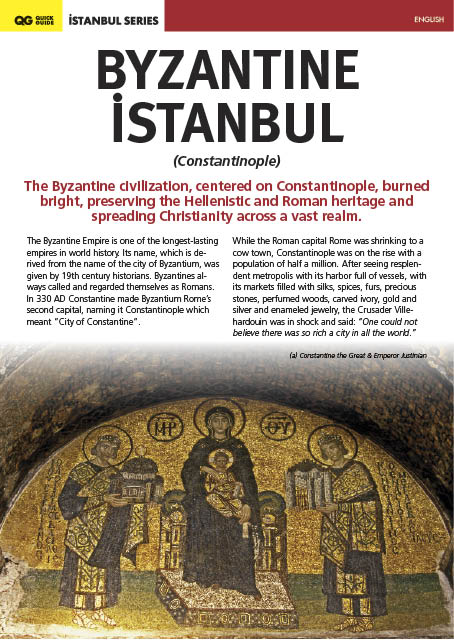Byzantine Istanbul
Byzantine Istanbul, also known as Constantinople during the Byzantine Empire, holds a rich history and cultural heritage as the capital of the Eastern Roman Empire. The city was a center of power, culture, and religion for over a millennium.
Byzantine Istanbul (Constantinople) Pamphlet
A user friendly and informative Pamphlet with illustrations and plans. Its content is very easy to understand. In addition to general information about the Byzantine Empire, it shows the illustrations and locations of all of the major buildings (palaces, walls, cisterns, forums, churches, aqueducts, etc.) in Istanbul during the Byzantine period.
Buy Byzantine Istanbul Pamphlet
ISBN: 978-605-88321-5-2 Quick guide Byzantine Istanbul (English, Turkish)
Available at Museum Shops in Turkey
Here are some key aspects of Byzantine Istanbul:
-
Capital of the Byzantine Empire: Constantinople, founded by Emperor Constantine the Great in 330 AD, served as the capital of the Byzantine Empire until its fall in 1453. It was strategically located at the crossroads of Europe and Asia, which contributed to its economic and political importance.
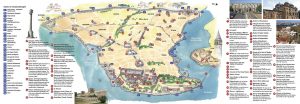 Hagia Sophia: One of the most iconic landmarks of Byzantine Istanbul is the Hagia Sophia (Ayasofya in Turkish). Originally built as a cathedral, it stands as a testament to Byzantine architectural and engineering excellence. It’s renowned for its massive dome and stunning mosaics.
Hagia Sophia: One of the most iconic landmarks of Byzantine Istanbul is the Hagia Sophia (Ayasofya in Turkish). Originally built as a cathedral, it stands as a testament to Byzantine architectural and engineering excellence. It’s renowned for its massive dome and stunning mosaics.- Theodosian Walls: The city was fortified with impressive defensive walls known as the Theodosian Walls. These walls were constructed to protect Constantinople from external threats and played a crucial role in its defense over the centuries.
- Chariot Races and the Hippodrome: The Hippodrome of Constantinople was an ancient stadium that hosted chariot races, athletic contests, and public events. It was a major social and entertainment center for the Byzantine population.
- Byzantine Art and Mosaics: Byzantine art, including intricate mosaics and frescoes, flourished in Constantinople. The mosaics adorned churches and palaces, depicting religious scenes, imperial figures, and everyday life.
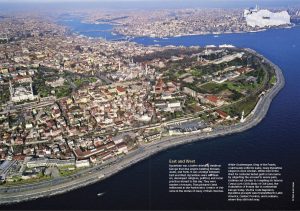 Emperor’s Palaces: The city was home to several imperial palaces, including the Great Palace of Constantinople and the Blachernae Palace. These palaces served as residences for Byzantine emperors and centers of political power.
Emperor’s Palaces: The city was home to several imperial palaces, including the Great Palace of Constantinople and the Blachernae Palace. These palaces served as residences for Byzantine emperors and centers of political power.- Churches and Religious Sites: In addition to Hagia Sophia, there were numerous other significant churches and religious sites in Byzantine Constantinople, such as the Chora Church (Kariye Museum), St. Irene Church, and more.
- Economic Hub: The city’s strategic location made it a hub for trade between Europe and Asia. Its economic prosperity contributed to its cultural vibrancy and the construction of grand architectural projects.
- Cultural Influence: Byzantine Istanbul was a melting pot of various cultures, languages, and religions due to its location as a crossroads between East and West. This cultural diversity contributed to the city’s unique character.
- Fall of Constantinople: The Byzantine Empire came to an end in 1453 when the Ottoman Empire, led by Sultan Mehmed II, captured Constantinople. This marked the end of an era and the beginning of the Ottoman period for the city, which was renamed Istanbul.
The legacy of Byzantine Istanbul is still evident in the city’s architecture, cultural heritage, and historical sites. Many of the landmarks and structures from the Byzantine era continue to be major attractions, drawing visitors from around the world to explore the rich history of this remarkable city.


